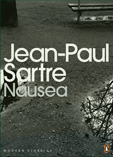Philosophical Fiction is a curious genre, in which the concepts of philosophy are expressed in a fictional idiom. The genre as a whole can be considered a continuum, with some of the books being more literary and some being more schematic elaborations of ideas. All of the books are to some extent examples of what might be called the 'typological' mode of philosophy, in which a set of concepts is 'embodied' in the form of a character, and then put into motion as they venture out into the world.
Nausea lies squarely at the philosophical end of philosophical fiction. There isn't really a plot, and the characters are all isolated philosophical types — there's nothing here to match the complex interrelation of characters in something like Simone de Beauvoir's The Blood of Others.
Antoine Roquentin walks around the city of Bouville, encountering objects and melting them with his gaze. The formula of these encounters is encapsulated in his degradation of the paintings in the Bouville art gallery. As they approach death, the Bourgeoisie of Bouville have "entrusted themselves to a celebrated painter" so that they might "carry out on their faces the dredging, drilling, and irrigation by which, all around Bouville, they had transformed the sea and the fields." In this way, the industrial constructions of the Bourgeoisie are given an aesthetic mirror in the form of the paintings commissioned before their deaths.
Antoine maintains unflinching eye-contact with the paintings. The Bourgeoisie are "ablaze with privilege" and push back strongly, but Antoine's gaze holds firm and soon enough "the fire dies out, and only an ashy residue remains". With his sandpaper-gaze, Antoine is able to 'see through' the essences of objects and reduce them to dust. He has already drowned History, Humanism, Love, Music, and Art in his pessimistic swamp, and now he approaches his final confrontation — with himself!
Antoine thinks that he has 'seen through' himself and expects to turn into dust, but he doesn't, because behind his essence lies a much more palpable existence — his body. For an abstract thinker such as Antoine, who is used to inhabiting the smooth spaces of thought, this profound and sudden exposure to the unmediated body is experienced negatively as 'the Nausea'. Thus, the sexual organs of a woman become wide-spreading leaves colonised by ants; the hands of another man resemble fat maggots; the town of Bouville is a primal scene overrun by disgusting vegetation.
Having rejected the world as it was presented to him, Antoine has pushed his nihilism to its farthest limit. And yet — he is only thirty years old! He is a young, young man. Jesus quit carpentry and started his ministry aged 30; Zarathustra went into the mountains and did not tire of his solitude for ten years. What is needed is an art of living. But what would a true art of living look like? Antoine doesn't know yet, but he at least has some idea of where not to look. His fallen idols have turned into dust, but he still has his body. Could the body become a ground of affirmation, rather than one of contempt? God spent six days creating the world and then rested on the seventh: he was already tired of it! Can you create the world and enjoy it too?

